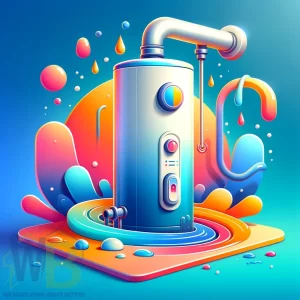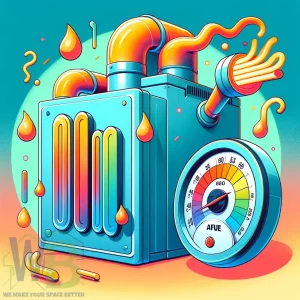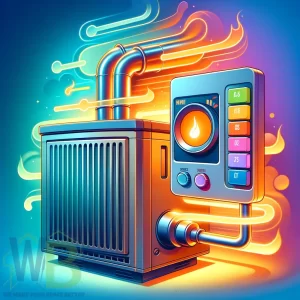Why Do Heat Pumps Have Defrost Systems? Heat pumps have defrost systems to prevent frost from building up on the outdoor coil. This happens especially when the temperature falls below freezing.
Frost on the coil can damage the heat pump and make it less efficient. So, the defrost system plays a crucial role in maintaining the heat pump’s performance.

Quick Summary
| Section | Key Points |
|---|---|
| Introduction | Heat pumps have defrost systems to prevent frost build-up on the outdoor coil, which can reduce efficiency and cause damage. |
| Heat Pump Defrost System Explained | The defrost system activates in cold temperatures to melt frost on the outdoor coil, typically by switching the heat pump to cooling mode temporarily. |
| Signs of Heat Pump Defrosting | Indications include the indoor unit pausing heating, the outdoor fan stopping while the compressor runs, and a possible noise from the reversing valve. |
| Heat Pump Cycle | Defrost cycles occur regularly, typically every 30 to 35 minutes, and last 5 to 15 minutes to maintain efficiency and prevent damage. |
| Common Defrost System Issues | Issues include inefficient or incomplete defrosting, component malfunctions, excessive defrosting, and the importance of preventive maintenance. |
| Prevention Tips | Regular maintenance, proactive monitoring, seasonal preparation, and energy efficiency practices help prevent defrost system issues. |
| Conclusion | Effective maintenance and understanding of the defrost system are crucial for the longevity and efficiency of heat pumps. |
Heat Pump Defrost System Explained
It’s a key component that ensures your heat pump operates effectively and efficiently during those chilly months.
What is a Heat Pump Defrost System?
- A Specialized Component: The defrost system in a heat pump is a tailored mechanism designed to tackle the issue of frost and ice formation. It’s not something you’ll find in all heating systems, but it’s essential in heat pumps due to their unique way of providing heat.
- Automatic Operation: This system operates automatically. It senses when frost accumulates on the heat pump’s outdoor coil and activates the defrost cycle. This automation ensures that the system works optimally without manual intervention.
- A Cycle of Efficiency: The main goal of the defrost system is to maintain the heat pump’s efficiency. Preventing ice build-up ensures the heat pump doesn’t overwork and uses energy efficiently.
How Does It Operate?
- Detecting Frost Build-Up: The system starts with sensors that detect frost on the outdoor coil. These sensors monitor the coil’s and ambient air temperatures, determining when a defrost cycle is needed.
- Initiating the Defrost Cycle: Once the system determines that defrosting is required, it temporarily shifts the heat pump into cooling mode. This might seem counterintuitive, but it’s a clever way to tackle the problem.
- Reversing the Process: The outdoor coil heats up by switching to cooling mode. This reverses the usual process where the coil absorbs heat. Instead, it now releases heat, melting away any frost or ice.
The Completion of the Cycle
- Melting the Frost: The frost and ice melt away as the coil warms up. This process usually takes a few minutes, depending on the build-up and the outdoor temperature.
- Resuming Normal Heating Mode: After the frost has melted, the system automatically switches back to the normal heating mode. This ensures that the heat pump continues providing warmth to your home without manual resetting.
- Regular Checks and Balance: This cycle repeats as needed throughout the winter months. It’s an automated process that ensures the heat pump operates efficiently without the risk of frost damage.
The Heat Pump Defrost System is an ingenious solution to a common problem in colder climates. It’s a testament to the advanced technology used in modern heating systems, ensuring that
How Can You Tell If The Heat Pump is Defrosting?
Knowing when your heat pump is in its defrost cycle can help you understand its normal operation and identify potential issues. Here are some clear signs to look out for:
Indoor Unit Signs
- Heating Pauses: The indoor unit temporarily stops heating when the heat pump defrosts. This is a normal part of the process.
- Fan Turns Off: Along with the heating, the fan in the indoor unit will also shut off. This might cause a momentary sense of quietness in the system.
- Temporary Change: It’s important to note that this is a temporary phase. The heating and fan operation will resume once the defrost cycle is complete.
Outdoor Unit Observations
- Fan Stops, Compressor On: The most noticeable sign is in the outdoor unit. The fan will stop running, but you’ll hear the compressor working. This indicates that the system reverses the flow to heat the coil.
- Visual Indicators: Some heat pumps have visual signals like a blinking light. This is designed to let you know that the unit is in defrost mode.
Reversing Valve Sounds
- Distinctive Noise: When the heat pump switches modes, you may hear a noise from the reversing valve. This sound signifies that the system is shifting from heating to cooling mode to start the defrost process.
Duration and Home Comfort
- Typical Cycle Time: The defrost cycle lasts 5 to 15 minutes. This duration is generally short enough not to impact your home’s temperature significantly.
- Monitoring for Issues: If your heat pump seems to be in defrost mode for an unusually long time or if you notice other irregularities, it could signal a problem. Issues such as a faulty thermostat, a damaged outdoor coil, or a malfunctioning reversing valve can affect defrosting.
Being aware of these signs helps ensure that your heat pump operates effectively and efficiently. It also aids in the early detection of any potential issues, allowing for timely maintenance and repairs.

Heat Pump Defrost Cycle
The frequency of the defrost cycle in heat pumps is a critical aspect of their operation, especially in cold climates. Let’s discuss how often heat pumps defrost and the factors influencing this process.
Regular Defrost Intervals
- Typical Frequency: Heat pumps generally enter the defrost cycle regularly. The norm is to defrost no more than approximately every 30 to 35 minutes.
- Temperature-Triggered Cycles: The defrost cycle is activated when the outdoor coil temperature falls below 32 degrees Fahrenheit. This drop in temperature leads to the formation of frost on the coil.
- Cycle Duration: A standard defrost cycle lasts 5 to 15 minutes. This duration is sufficient to remove frost from the outdoor coil, preventing damage and maintaining the pump’s efficiency.
Programming and Defrost Controls
- Interval Settings: Heat pumps can be programmed to check if a defrost cycle is needed at different intervals. These intervals can be set every 30, 60, 90, or 120 minutes, depending on the model and settings.
- Types of Defrost Controls: There are mainly two types of defrost controls – time-temperature and demand defrost.
- Time-Temperature Based: In this type, the defrost cycle is initiated based on a combination of time and temperature readings. It’s a pre-set system that activates the defrost cycle after a specific period if the temperature conditions are met.
- Demand Defrost: This system is more sophisticated. It initiates the defrost cycle only when necessary, based on real-time conditions. This method can be more energy-efficient, as it avoids unnecessary defrost cycles.
Importance of Defrost Frequency
- Preventing Damage: Regular defrosting is crucial to prevent damage to the heat pump. If frost builds up excessively, it can strain the system and lead to malfunctions.
- Maintaining Efficiency: Frequent and timely defrosting ensures the heat pump operates at peak efficiency. Without it, the system might use more energy to achieve the same heating level, resulting in higher energy bills.
- Adaptation to Environmental Conditions: The flexibility in defrost interval settings allows the heat pump to adapt to different climates and environmental conditions, providing optimal performance regardless of the weather.
The defrost cycle in heat pumps is a well-coordinated process vital to the system’s overall functionality and efficiency.
5 Common Heat Pump Defrost System Issues
Heat pumps are essential for maintaining comfortable temperatures, especially in colder climates. Let’s look at five common problems and understand their impact on the heat pump’s performance.
1. Inefficient Defrost Cycle
- Issue: The defrost cycle might not work as effectively. This inefficiency can lead to ice buildup on the outdoor coil.
- Consequences: Reduced efficiency and potential damage to the unit. Ice accumulation hinders heat transfer, making the system work harder than necessary.
- Possible Causes: This can be due to various reasons, including a malfunctioning defrost timer, controls, or environmental factors like extremely low temperatures.
2. Incomplete Thawing
- Issue: Sometimes, the heat pump may not completely thaw the ice during the defrost cycle.
- Consequences: This partial thawing can lead to a gradual ice buildup, affecting the heat pump’s efficiency.
- Factors Leading to This Issue: Possible causes include a dirty outdoor coil, low refrigerant levels, or a faulty defrost termination sensor. Each can prevent the system from reaching the necessary temperatures to melt the ice fully.
3. Component Malfunctions
- Issue: The defrost system can suffer from various component malfunctions.
- Consequences: These malfunctions can disrupt the normal operation of the defrost cycle, leading to either insufficient defrosting or over-defrosting.
- Typical Malfunctions: Issues can arise from faulty temperature sensors, wiring problems, low refrigerant levels, or a malfunctioning reversing valve.
4. Excessive Defrosting
- Issue: A heat pump may sometimes enter the defrost mode more frequently than necessary.
- Consequences: This excessive defrosting wastes energy and can cause wear and tear on the system.
- Potential Causes: This can be due to a faulty thermostat, wiring issues, or residual ice from previous defrost cycles that trick the system into initiating another cycle prematurely.
5. Preventive Measures
- Prevention: Regular maintenance is key to preventing these issues.
- Key Practices: This includes keeping the outdoor unit clean, ensuring proper airflow, and changing filters regularly. These simple steps can help maintain the efficiency of the defrost system and prevent the above issues.
- Regular Checks: It’s also a good idea to have a professional periodically check the system, especially before the onset of the colder seasons.
These common issues with heat pump defrost systems can help you identify and address problems early, ensuring your heat pump operates efficiently and effectively.
Prevention Tips
Regular maintenance and proactive steps are essential to ensure your heat pump’s defrost system operates effectively and prevents potential issues. Here are some key prevention tips:
Regular Maintenance
- Clean and Clear Outdoor Unit: Ensure the area around the outdoor unit is clear of debris, leaves, and snow. A clean unit allows for proper airflow and reduces the strain on the system.
- Regular Filter Changes: Replace or clean the air filters regularly. Clogged filters can hinder airflow, impacting the heat pump’s overall efficiency and defrost system.
- Professional Inspection: Schedule annual or bi-annual inspections with a qualified technician. They can check refrigerant levels, electrical connections, and overall system health.
Proactive Monitoring
- Keep an Eye on Defrost Cycles: Be aware of how often and how long the defrost cycles occur. Frequent or prolonged cycles could indicate a problem.
- Listen for Unusual Noises: Hissing or banging during operation or defrost cycles can signal issues with the reversing valve or other components.
- Observe Performance: If you notice a decrease in heating efficiency or other performance issues, it may be time for a system check-up.
Seasonal Preparation
- Pre-Winter Check: Before the onset of cold weather, thoroughly check the system. This includes cleaning the coils and checking for any potential issues.
- Protect Against Extreme Weather: In areas with heavy snowfall or ice, consider protective measures such as installing a cover over the outdoor unit to prevent excessive ice accumulation.
Energy Efficiency Practices
- Smart Thermostat Use: Utilize a programmable thermostat to optimize the heating schedule, reducing unnecessary strain on the system.
- Proper Insulation: Ensure your home is well-insulated. This helps maintain a consistent temperature and reduces the workload on the heat pump.
- Use Supplementary Heating: Additional heating sources can alleviate pressure on the heat pump in icy conditions, preventing overwork and frequent defrost cycles.
Following these tips can help prevent issues with your heat pump’s defrost system, ensuring it runs smoothly and efficiently for years. Regular maintenance, proactive monitoring, and appropriate seasonal preparations are key to a well-functioning heat pump.
Heat Pumps Defrost Systems: Conclusion
the intricacies of a heat pump’s defrost system is key to ensuring its efficient and long-lasting operation. From recognizing the signs of a heat pump in defrost mode to being aware of common issues and their preventative measures, this knowledge empowers homeowners to maintain their systems effectively.
Regular maintenance, being attentive to the system’s performance, and employing simple yet effective preventive measures can significantly enhance the longevity and efficiency of your heat pump.
Remember, a well-maintained heat pump provides consistent comfort and contributes to energy savings and a reduced environmental footprint.







